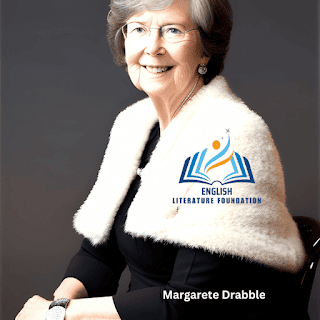Exploring the Timeless Tale of "The Ice Age" by Margaret Drabble
Introduction
In this detailed summary of "The Ice Age" by
Margaret Drabble, we delve into the captivating world of the novel and explore
its profound themes and intricate characters. "The Ice Age" is a
remarkable literary work that delves into the complexities of human
relationships, personal growth, and the ever-evolving dynamics of society. Let
us embark on this journey through Drabble's compelling narrative, drawing upon
poignant quotes from the text to provide a comprehensive understanding of the
story.
Understanding the Historical Context
To fully grasp the narrative of "The Ice Age," it
is essential to comprehend the historical backdrop against which the story
unfolds. Margaret Drabble skillfully transports readers to the 1970s, a period characterized
by societal transformations and shifting gender roles. The author captures the
essence of this era, exploring the effects of feminism and the ever-evolving
power dynamics between men and women.
"The Ice Age" is set in London during the 1970s, a
time of social and cultural transformation. The story revolves around the life
of its protagonist, Frances Wingate, a highly introspective and intelligent
woman in her forties. Frances finds herself at a crossroads, grappling with the
challenges of aging, identity, and her place in a rapidly changing world.
Exploring the Protagonist's Journey
"The Ice Age" revolves around the life of its
protagonist, Elizabeth, a middle-aged woman navigating her way through a
rapidly changing world. Through Drabble's exquisite prose, we witness
Elizabeth's personal growth and her struggle to reconcile her own desires with societal
expectations.
Elizabeth's journey is poignantly portrayed through passages
such as:
"I think it is necessary to acknowledge a point of
crisis, to accept the fact of change, to find out what is on the other side of
it. If you accept the limits others have set for you, you have failed. You have
chosen to fail."
These profound words encapsulate Elizabeth's determination
to break free from societal constraints, urging readers to question the
boundaries imposed upon them and embrace the possibility of self-discovery.
Themes:
1.
Identity and
Self-Reflection
One of the central themes in "The Ice Age" is the
exploration of identity and the intricate nature of self-reflection. Drabble
delves deep into the human psyche, unraveling the complexities of individuality
and the impact of societal expectations on personal growth.
Through Elizabeth's introspective journey, the novel prompts
readers to confront their own sense of self and consider the factors that shape
their identity. Drabble eloquently expresses this sentiment when she writes:
"For what I seek is a state of mind, not a state of
marriage. My state of mind is human and restless, dissatisfied with its own
limitations, ever in search of external support and stimulus."
These introspective passages invite readers to reflect on
their own lives and aspirations, creating a profound connection between the
narrative and the human experience.
2.
The Dynamic Nature
of Relationships
"The Ice Age" also delves into the intricate web
of relationships, shedding light on the multifaceted dynamics that shape human
connections. Drabble masterfully explores the complexities of love, friendship,
and familial bonds, showcasing the interplay between these relationships and
the broader social context.
With her remarkable storytelling prowess, Drabble presents
thought-provoking insights into the intricacies of relationships. As she
writes:
"We are all, on some level, or at some time, unfair to
each other. Our expectations are often mismatched, our desires
conflicting."
These profound observations offer readers a window into the
human condition, provoking contemplation on the delicate balance between
personal desires and the needs of others within the realm of relationships.
3.
Social Change and
Cultural Shifts
Set against the backdrop of 1970s London, "The Ice
Age" captures the societal changes that permeated the era. Drabble
skillfully weaves these transformations into the narrative, showcasing the
impact they have on Frances' personal journey. The novel offers a thought-provoking
exploration of feminism, shifting gender roles, and the clash between
traditional values and evolving societal norms.
"The world was changing, and it frightened her." -
Margaret Drabble, The Ice Age
4.
The Passage of Time
and its Effects
As the title suggests, "The Ice Age" delves into
the passage of time and its profound impact on individuals and society. Drabble
takes us on a journey spanning decades, skillfully portraying the changes that
occur within her characters' lives. Through the lens of time, we witness the
unfolding of personal histories and the shifts in societal norms. Drabble's
exploration of time serves as a poignant reminder of the transient nature of
existence and the inevitability of change.
Character Analysis
In Margaret Drabble's novel "The Ice Age," a
diverse cast of characters populates the pages, each contributing to the rich
tapestry of the narrative. These characters are skillfully crafted, with
distinct personalities and complex motivations. Let's delve into the depths of
some of the key characters in the novel.
1. Alix Bowen
Alix Bowen is the central protagonist of the story, a
strong-willed and introspective woman who undergoes a profound journey of
self-discovery. Alix is portrayed as an intellectual, often feeling detached
from her surroundings and struggling to find her place in the world. She yearns
for meaningful connections but is also haunted by a sense of fragmentation
within herself. Throughout the novel, Alix's character evolves as she grapples
with the complexities of identity, ultimately seeking a sense of wholeness and
fulfillment.
2. Humphrey Clark
Humphrey Clark is a fascinating character who forms a
significant relationship with Alix. He is a gentle and somewhat introverted
man, contrasting with Alix's more assertive nature. Humphrey is depicted as a
writer and scholar, deeply engaged in his studies and research. His presence in
Alix's life brings a sense of stability and companionship, allowing both
characters to explore their individual identities while navigating the
challenges of their relationship.
3. Brian Tremayne
Brian Tremayne is Alix's enigmatic former lover, who
reappears in her life after a significant absence. He is portrayed as
charismatic and unconventional, with a free-spirited nature. Brian's character
adds an element of unpredictability and emotional turmoil to the story. His
reemergence reignites Alix's unresolved feelings and forces her to confront the
complexities of their shared history.
4. Midge Bowden
Midge Bowden, Alix's half-sister, plays a pivotal role in
the novel. She is depicted as a vibrant and vivacious character, embracing a
bohemian lifestyle. Midge's personality contrasts sharply with Alix's more
reserved nature, yet they share a deep bond and a sense of loyalty to each
other. Midge's character serves as a catalyst for Alix's self-discovery,
challenging her perceptions and pushing her outside of her comfort zone.
5. Selina Pierce
Selina Pierce is a close friend of Alix and Midge, and her
character provides an intriguing perspective on the themes of identity and
societal expectations. Selina is portrayed as a successful and ambitious woman
who defies traditional gender roles. Her fierce independence and determination
offer a contrast to the more introspective nature of Alix and Midge, inspiring
them to question their own choices and aspirations.
6. Mother and Father Bowen
Alix's parents, referred to as Mother and Father Bowen,
represent the influence of family and upbringing on the characters'
development. They embody the expectations and societal norms of their time,
contrasting with the unconventional paths chosen by Alix and Midge. While their
appearances in the novel are limited, their presence looms large, shaping the
characters' perceptions and choices.
These are just a few of the intriguing and multifaceted
characters that populate "The Ice Age" by Margaret Drabble. Through
their interactions, struggles, and personal journeys, Drabble offers readers a
nuanced exploration of the human experience and the complexities of identity.
As readers delve into the lives of these characters, they are invited to
reflect on their own paths of self-discovery and the intricate relationships
that shape their lives.
Conclusion
"The Ice Age" by Margaret Drabble stands as a
testament to the power of exceptional storytelling and thought-provoking
narratives. Through its exploration of historical context, themes of identity
and self-reflection, and the dynamic nature of relationships, Drabble
captivates readers with her rich and compelling prose.
As we bid farewell to Elizabeth and the profound insights
she brings,we are reminded of the enduring impact of literature in illuminating
the human experience. "The Ice Age" serves as a timeless work that
challenges societal norms, prompts self-reflection, and celebrates the
complexities of relationships. Margaret Drabble's masterpiece continues to
captivate readers and remains a significant contribution to the world of
contemporary literature.

